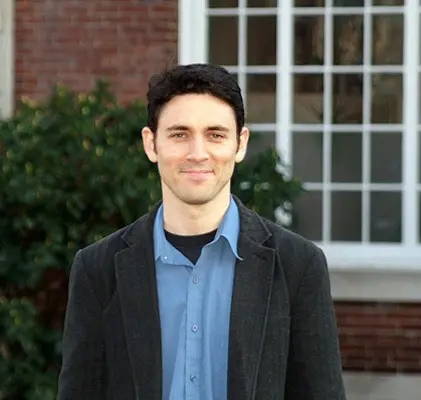Saverio Spagnolie has been fascinated with the movement of tiny forms of life for well over a decade. But as an assistant professor of mathematics at the University of Wisconsin-Madison, he doesn’t just casually observe this biolocomotion. For him, it’s an invitation to identify the mathematical laws that predict and govern it.
 Saverio Spagnolie
Saverio Spagnolie
And Spagnolie, who has an affiliate appointment with the Department of Chemical and Biological Engineering, says a better understanding of these fundamental laws may unleash new and creative ideas for containing the movement of bacteria that harm us, or conversely, for promoting the activity of helpful ones.
An example for containing harm is a life-threatening condition called endocarditis: the formation of a bacterial biofilm that adheres to the inner lining of our heart. It begins with germs traveling from, say, the mouth through the bloodstream to already damaged areas of the heart. If that biofilm covers the heart valve, the consequences can be dire.
“When millions of bacteria form a matrix to solidify their stranglehold on the valve, this biofilm changes its mechanical properties, making it harder to pump blood into our body,” Spagnolie says. “Treating endocarditis is exceptionally difficult, but if left untreated, the condition is almost always fatal.”
A few years ago, Spagnolie developed a mathematical model that predicts which types of bacteria are attracted to surfaces by fluid mechanical forces alone. In collaboration with engineers and physicians, this model may eventually help develop new drugs for bacterial infections, including endocarditis, dental caries and other conditions associated with biofilms. They might destroy an existing biofilm faster or, if a patient is known to be at risk for the condition, prevent it from forming in the first place.
Modeling collective bacterial movement—an example of so-called active matter research—may also help tackle the growing problem of antimicrobial resistance: the fact that many bacteria, viruses and fungi have developed genetic resistance to the arsenal of antibiotic drugs that has protected us from deadly diseases since the late 1930s.
The physical properties of their surroundings strongly influence the collective movement of bacteria. For example, Escherichia coli, one of the most abundant organisms in the human gut, will either swim individually or swarm as a coordinated group, depending on the perceived viscosity of their environment.
“Swarming bacteria are a micro-scale version of flocking birds in the sky, but in a viscous universe with no inertia,” Spagnolie explains. “And different types of bacteria vary greatly in their ability to swarm.”
A high density of microbes, even if they are not moving, can confer resistance to antibiotic concentrations that would kill a small number of cells. Researchers have also shown that the ability to swarm provides an additional survival advantage—and that this advantage doesn’t result from turning on genes that break down the antibiotic drug, but is due to the speed and other physical properties of the motion itself.
Spagnolie has taken this finding one step further: Beyond an improved ability to survive a chemical threat, swarming also seems to help the group as a whole expand into new cellular territory.
“Mathematically speaking, bacteria moving in a fluid create a flow field, which influences the movement of nearby bacteria beyond their own active movement,” he says. “Our recent work shows how this flow field accelerates the invasion of new, previously bacteria-free spaces and how the spreading pattern depends on the shape of the bacterial cell and its mechanism of self-propulsion.”
While Spagnolie focuses on the theoretical underpinnings of biolocomotion, the questions he tackles tend to start with biological experiments, many of which are relevant to human health. That’s why he interacts closely with applied departments and enjoys co-advising graduate students and postdoctoral fellows in chemical and biological engineering with colleagues who have similar interests, including David Lynn, Nicholas Abbott, Daniel Klingenberg and Michael Graham.
“Compared to my mathematics students, the engineering students have had more training in experimental work, so even if they don’t do experiments themselves, they can relate to the realities of a physical problem, know what is more or less important and are comfortable interacting with life scientists,” Spagnolie says. “Working with both kinds of students is certainly one of the biggest benefits of my affiliate appointment with the Department of Chemical and Biological Engineering.”